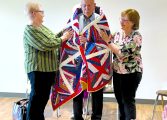Many of the icons in the chapel – the icons that are such an integral part of both the service and the faith – were written by Mefodii.
An energetic figure wearing the black cassock and cap – or skofia – of his faith and with a grizzled beard spilling down his chest, Mefodii is both earnest and engaging when he discusses the Eastern Orthodox faith and its integral component, iconography.
“First off we have to understand iconography is not art,” he said. “Art by its nature is egocentric, which is positive, because it is a revelation of the person in some shape or form. Poetry or a painting of some sort – even carpentry, gardening, or music – all this type of thing is art.”
In contrast, Mefodii explained, “Iconography – although it uses an art form – is revelation. What God reveals, we try to pass on. So when we are writing an icon, we are not creating something new. We are taking something that has been revealed and trying to portray that revelation.”
Mefodii is a member of the Prosopon School of Iconology. The icons themselves are constructed of wood panels covered with linen and then written with egg tempera. All parts of the icon are natural.
“In this school, we have three principles that we have to follow,” he said. “Meditation, practice, and contemplation.”
Meditation, Mefodii said, “is asking the questions why, how, what color, why this line – this type of thing. When I am writing the icon I have to sit down and say ‘What am I doing? How does this line fit here? What color do I use, which pigment do I use – how much pigment – how much egg, how much water?’
“Once I understand it and grasp the technique,” he continued, “then I do the practice – I actually do the writing of the icon. If I am writing an icon of a particular saint, I have to read all I can to learn as much about that saint as I can, so the spirit of that person will be with me while I am writing the icon.”
Once the icon is written, Mefodii said, “I have to sit back and contemplate it – and contemplation in the eastern Christian tradition is not thinking; it is experiencing the presence of God. That is what the icon is to do – to bring us to an experience of the presence of God.”
Not far from the skete, between Palmyra and Wilmington, is Mefodii’s small studio, housed in a former one-room schoolhouse. The room is set with tables draped with cloth at which his students work; icons in various stages of completion rest on shelves against the wall, awaiting the students’ return.
The process for writing an icon in the Prosopon method is highly proscribed; each step has both practical and spiritual significance, Mefodii explained. Even the tints used each have meaning and context.
The seven colors of the rainbow have significance, Mefodii said. “In the Prosopon School the first three colors – red, orange, and yellow – symbolize the created visible world. The last three colors – light blue, indigo, and violet –are symbolic colors for the created invisible world. That is the world of the angels – the angelic realm and also the world of the Trinity,” he said.
“The middle color, green, is the symbolic color for the human person,” Mefodii said. “Because the human person is created in the image of God and according to the likeness of God, the human person is the bridge between the created visible world – the body – and the invisible created world – the soul.”
The boards of the icon are always arranged vertically, a pathway between the divine and the earthly. The center part of the board is carved away so that the remaining wood forms a border around the icon.
The next step of the process is to apply fine linen to the recessed portion of the icon using hide-skin glue. The linen, which should be the finest available, represents both the swaddling clothes of Jesus at the nativity and the burial clothes of Christ.
“Already the board becomes transfigured into something about the Lord, his life, the incarnation, God becoming a human being,” Mefodii said.
Then gesso – a paste of white marble dust and water – is applied and sanded in layers. “The gesso is pressed into the linen and sanded,” Mefodii said. “You end up with this very beautiful, smooth, very white surface that becomes a symbol of the mind of God.”
The image is transferred from a sketch to the gesso. “The iconographer transfers the sketch to the board and then etches the sketch into the board.” In doing so, Mefodii said, the iconographer is “actually entering into the mind of God, becoming a co-creator with God.”
Writing an icon in the Prosopon School always begins with red. Once the red clay is put on the board it is sanded and burnished, Mefodii said. This process symbolizes “our ascetical practice of prayer and repentance in our own lives,” he said.
The next color used is green – the color that “symbolizes the unity between the visible and invisible world,” Mefodii said. He explained that the green tint is applied everywhere there will be flesh or hair in the icon.
The icon is then written in a series of highlights and floats, or applications of pigment. The writer strives to keep the pigment light enough so that light can pass through, yet opaque enough so that the colors on the icon become rich. Each layer of highlights and floats has significance. Lines are applied to give definition and to quell the chaos of color – separating the tints into order and reasonableness.
Once the icon is finished, it must go through one more stage before it becomes what Mefodii considers to be “miracle-working.” Iconographers put their icons through a physical process that mirrors the spiritual process undertaken by a new believer.
Since the icon was written with water, it is considered by believers to have been baptized. In the early church, the next stage for becoming a Christian was to be “sealed in the gifts of the Holy Spirit,” – a process which Mefodii said involved blessing the initiate with oil. Therefore, oil is applied to the icon in the form of the cross and then rubbed into the work. The oil soaks through all of the layers of tint, gesso and linen, then into the wood itself. The icon is then considered sealed.
The final step for a new believer is to be brought into the church to become part of the “worshipping community,” Mefodii said. Similarly, the icon is brought to church. The priest can bless it, or it can be left on the “holy table” for 40 days, Mefodii said. At that point, “It can be taken home and it can be a miracle-working icon,” Mefodii said.
“Iconography is participating in God’s revelation of God’s self,” said Mefodii, “so the iconographer is someone who cannot put his or her own desires into the icon.” This requirement, he said, “demands that the person who has become an iconographer…be a person of prayer [and] a person of faith.”
Anyone interested in attending services at the Skete of St. Maximos or becoming a student of iconography should contact Father Mefodii at hmmefodii@gmail.com




